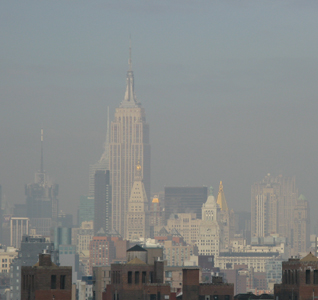NYC Green Infrastructure Plan

Traditional approaches to reduce CSOs further would include the construction of additional, large infrastructure, but the remaining opportunities for such construction are very expensive, and do not provide the sustainability benefits that New Yorkers rightly expect from multi-billion dollar investments of public funds.
This Green Infrastructure Plan presents an alternative approach to improving water quality that integrates ―green infrastructure,‖ such as swales and green roofs, with investments to optimize the existing system and to build targeted, smaller-scale ―grey‖ or traditional infrastructure. This is a multi-pronged, modular, and adaptive approach to a complicated problem that will provide widespread, immediate benefits at a lower cost. The green infrastructure component of this strategy builds upon and reinforces the strong public and government support that will be nec- essary to make additional water quality investments. A critical goal of the green infrastructure component is to manage runoff from 10% of the impervious surfaces in combined sewer water- sheds through detention and infiltration source controls.
New York City’s ―Green Strategy‖ is nimble enough to incorporate new technologies and approaches as they emerge during the implementation of our plan. DEP will preserve its ability to pursue larger grey infrastructure if necessary and appropriate in the event that the Green Strategy cannot achieve water quality objectives in a particular drainage area. Promoting green infrastructure has been endorsed by the U.S. Environmental Protection Agency (EPA) and the New York State Department of Environmental Conservation (DEC). Under Administrator Lisa Jackson, EPA has testified that green infrastructure is an ―effective response to a variety of environmental challenges that is cost-effective, sustainable, and provides multiple desirable environmental outcomes.‖ (Testimony before the U.S. House of Representatives, Committee on Transportation and Infrastructure, Subcommittee on Water Resources and Environment, March 19, 2009)
The goal of 10% capture over 20 years could be met through a combination of:
- Three percent (3%) impervious area capture by street trees, swales, and sidewalks that are rebuilt or retrofitted with additional controls;
- Three percent (3%) impervious area capture by performance standards on new and expanded developments that would include bio-infiltration, blue and green roofs, sub-surface detention / infiltration, or other source controls;
- Three percent (3%) impervious area capture by existing schools, residences, and other development; and
- One percent (1%) impervious area capture by additional planted areas in open spaces and waterfront areas.
To accelerate the implementation of green infrastructure, DEP is building more than 20 demonstration projects in collaboration with other city agencies and local authorities. These demonstration projects are testing techniques that are appropriate for a variety of land uses:
- Green roofs for rooftop stormwater detention and retention;
- Porous pavement for parking lots;
- Tree pits, street side swales, and porous pavement for roadways;
- Green streets, medians, and curbside extensions for roads;
- Constructed wetlands and swales for parks;
- A variety of these techniques for high density multi-family housing; and
- Rain barrels for low density single family housing.




